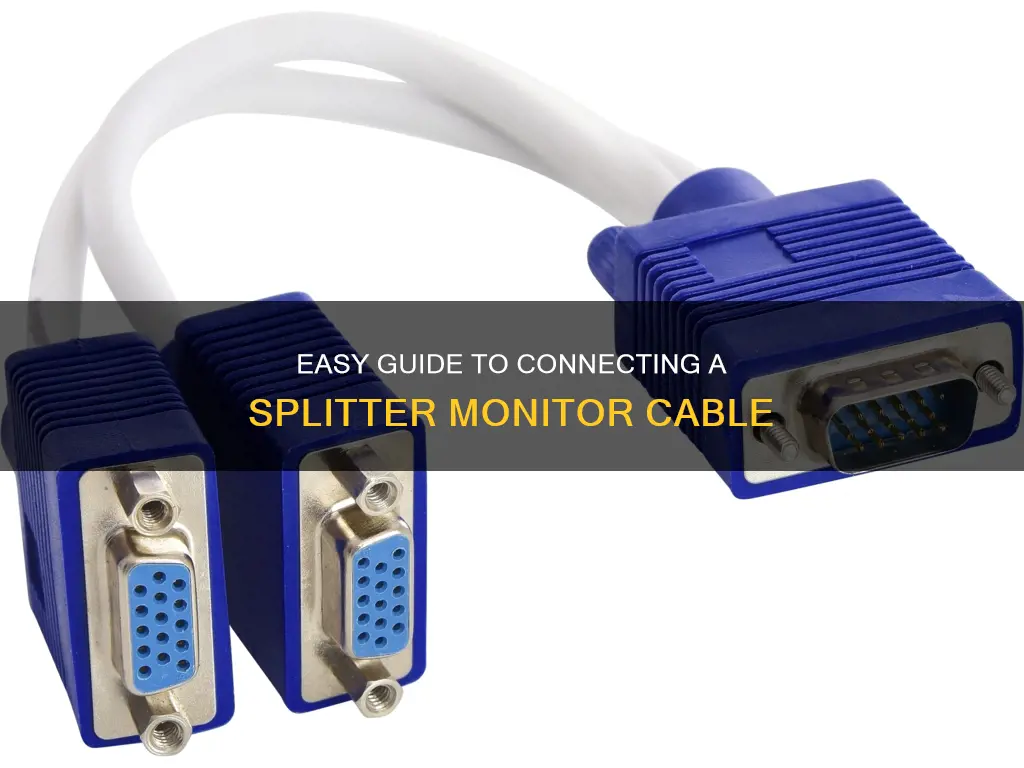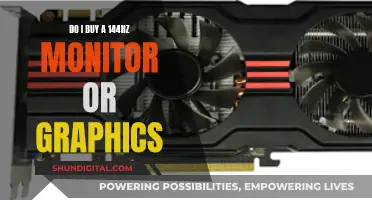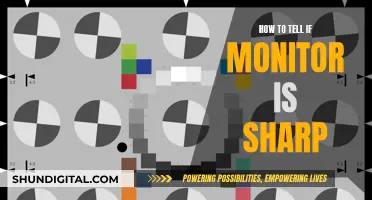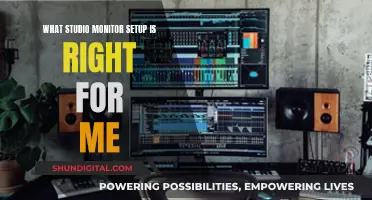
A monitor cable splitter is a device that allows you to connect two monitors to a single computer using a single cable. This is useful if you want to set up a multi-monitor configuration, or if you want to share a single display with multiple people. There are several types of monitor cable splitters, including HDMI splitters, DisplayPort splitters, and DVI splitters. Setting up dual monitors is a quick and easy process that takes just a few minutes.
What You'll Learn

VGA splitters and how they work
VGA splitters are cables or devices that allow you to separate a video signal and connect those individual signals to multiple devices. They are often used for connecting projectors and televisions to your computer, but they can also be used to connect multiple monitors to the same computer.
VGA splitters work by connecting to the computer's video port and intercepting the computer video signal. The signal then flows to a separator that breaks the signal into multiple signals, which continue on to their respective devices. As the VGA splitter must degrade the signal in order to separate it, many splitters are capable of boosting video signals.
To attach a VGA splitter, first, turn off the computer and the monitors. Locate the main cable coming off the splitter and connect it to the VGA port on your computer. Then, connect the first VGA connector to the VGA port of one of your monitors, and the second VGA connector to the second monitor. Secure the connectors with thumbscrews, being careful not to over-tighten.
Turn on the power to your computer and monitors. The screen will now expand across both monitors. You can use the system with the default settings or customise the setup. To do this, enter your screen settings and choose which is the primary screen and which is secondary. You can also opt to use the screens like one large monitor, but some resolution quality may be lost.
Connecting Your BenQ Monitor to an iMac
You may want to see also

HDMI splitters and their various configurations
HDMI splitters are a great way to display an HDMI source on multiple devices. They are designed to take the HDMI signal from one source and split it into two or more identical signals, allowing you to connect multiple HDMI devices to a single HDMI input. This is especially useful when you want to display the same content on multiple screens, such as during presentations, in conference rooms, or for home entertainment setups.
There are two types of HDMI splitters: passive and active. Passive HDMI splitters are simple devices that split the HDMI signal across multiple receivers without requiring external power. They are typically sufficient for most needs and are useful when you want to share a single source with multiple displays. However, they may have limitations such as distance constraints and potential signal degradation. On the other hand, active HDMI splitters have built-in amplification to boost the signal strength and maintain signal quality over longer distances. These splitters require an external power source and are particularly useful when the distance between the source device and the displays is greater.
When setting up an HDMI splitter, you'll need to connect your source device, such as a Blu-ray player, streaming device, or gaming console, to the input of the splitter using an HDMI cable. Then, connect the output(s) of the splitter to your desired display devices, such as TVs or monitors, using additional HDMI cables. Finally, power on your devices and make any necessary adjustments to your source device's settings.
HDMI splitters come in various configurations, such as 1x2, 1x4, 1x8, and 1x16, allowing you to connect to multiple displays simultaneously. For example, with a 1x2 HDMI splitter, you can connect one source device to two display devices, and both devices will receive the same picture and audio quality as the source device.
It's important to note that HDMI splitters have limitations. For instance, if your source device and the connected displays have different resolutions, the splitter will default to the lowest common resolution. Additionally, copyrighted content may be difficult to duplicate due to content protection systems like HDCP. To ensure optimal performance, choose an HDMI splitter that supports the specifications, resolutions, and audio formats you need.
Replacing the LCD Monitor Cable on Your Asus Q502LA
You may want to see also

DisplayPort splitters and their additional features
DisplayPort splitters are devices that allow you to connect multiple monitors or displays to a single DisplayPort output on your laptop, Ultrabook, PC, or graphics card. They are particularly useful if you want to create a multi-monitor setup for gaming, digital signage, or simply to enhance your productivity by extending your screen across multiple displays.
One notable feature of DisplayPort splitters is their support for Multi-Stream Transport (MST) technology. MST allows you to configure your additional monitors in different ways. You can use them as a splitter, displaying the same content on each monitor, or you can use the extended mode, which allows you to use the monitors independently with different content on each screen. Additionally, some DisplayPort splitters support an expand mode, where you can join multiple monitors together to act as a single large display, enhancing your field of view.
When purchasing a DisplayPort splitter, it's important to consider the resolution capabilities. Some splitters support ultra-high resolutions such as 4K @120Hz or even 8K @60Hz, ensuring crisp and clear visuals on your displays. Additionally, certain DisplayPort splitters are designed to be plug-and-play, requiring no additional driver installations, making them convenient and easy to set up.
Another feature to look out for is the number of outputs on the splitter. While most DisplayPort splitters offer a 1-in-2-out configuration, allowing you to connect two monitors, there are also splitters with a 1-in-3-out configuration, enabling you to connect up to three displays simultaneously. This can be especially useful if you require a more expansive setup for tasks that demand a large screen real estate.
Asus Monitor Drivers: A Comprehensive Guide for Users
You may want to see also

DVI splitters and their limitations
DVI splitters are a useful tool for connecting multiple devices to one display without compromising quality or resolution. They are especially handy for gamers who want to connect multiple consoles, or for business owners who need to display presentations across multiple screens.
DVI (Digital Video Interface) is a popular option for transmitting high-quality video signals. It allows for an uncompressed digital video transfer from one device to another, ensuring no data loss and that the original quality of the image is retained.
There are a few limitations to consider when using a DVI splitter. Firstly, it is important to ensure compatibility with your device and that the splitter supports the required resolution. Some splitters may not support high-resolution displays or certain video formats. Additionally, cable length can be a limiting factor. Longer cables may be required for certain setups, but these can result in signal degradation and poor image quality. To combat this, a DVI booster or extender cable can be used to maintain a strong signal over longer distances.
Another limitation of DVI splitters is that they cannot be used to split audio signals. They are designed specifically for splitting video signals, so an audio distribution system would need to be used for this purpose.
Furthermore, while a DVI splitter can be used with monitors of different resolutions, it is important to note that each monitor will display at the lowest common resolution. To utilise a monitor's higher resolution capabilities, the settings on the computer would need to be adjusted to match.
Lastly, while a DVI splitter can be used to extend the distance between a computer and its monitors, common issues such as signal degradation or loss may arise. A DVI booster or extender cable is recommended to overcome this issue and ensure a strong signal.
China's Internet Surveillance: Monitoring Online Activities
You may want to see also

Other cable splitters for older technologies
While VGA, DVI, and HDMI splitters are the most common types of cable splitters today, there are also splitters for older technologies. These include:
- RCA splitters, which split or merge audio or video signals from soundbars and other analog devices.
- Coaxial cable splitters, which are essential for anyone who has more than one television in their home and wants to ensure their signal doesn't get lost.
- 3.5mm audio cable splitters, which are used to connect older devices that are not Bluetooth-capable.
- VGA Y-splitter cables, which enable you to use two monitors and are commonly used by professionals in fields like graphic design and gaming.
Choosing the Right Rope Size for Monitor Windvane
You may want to see also







